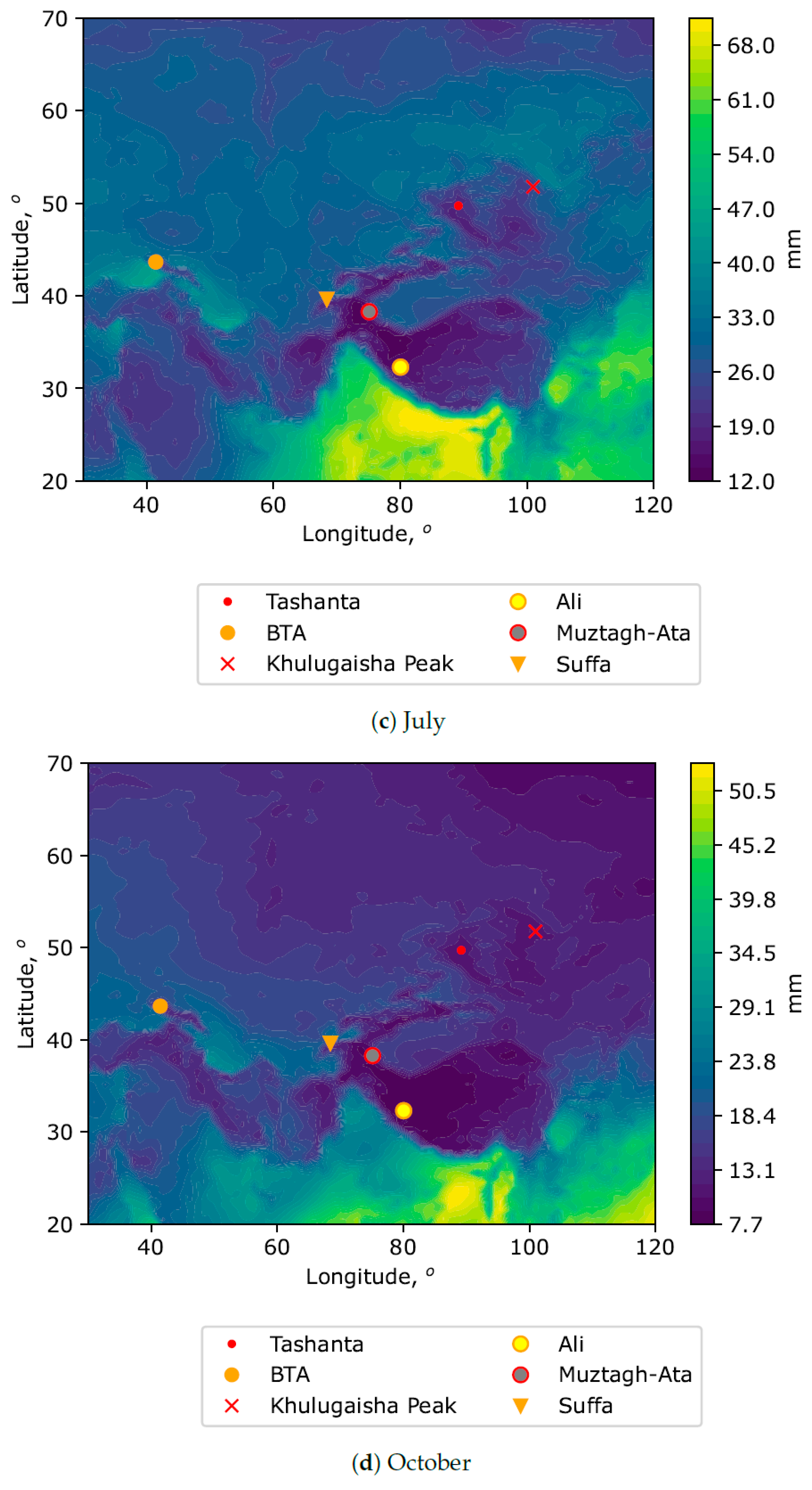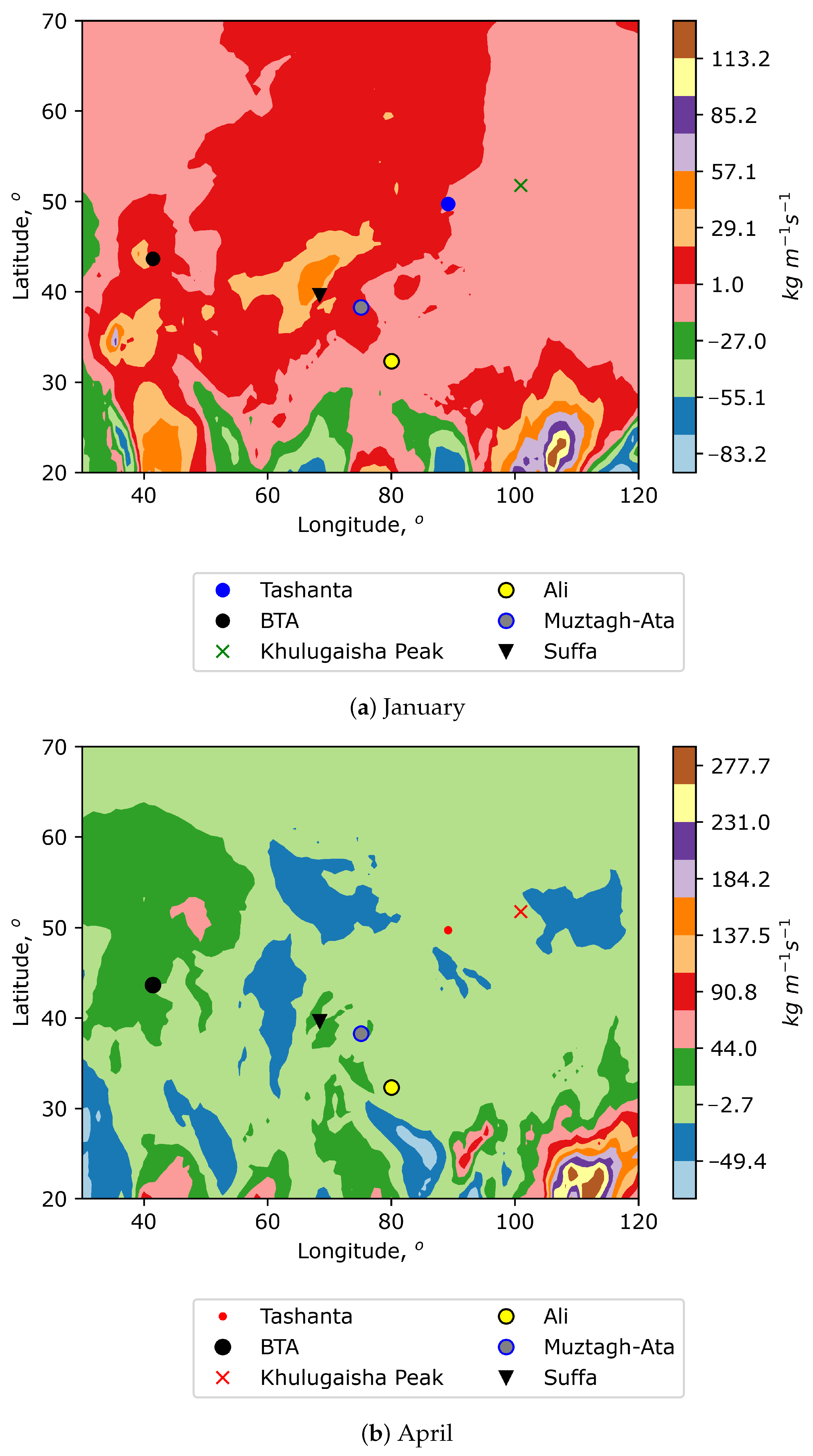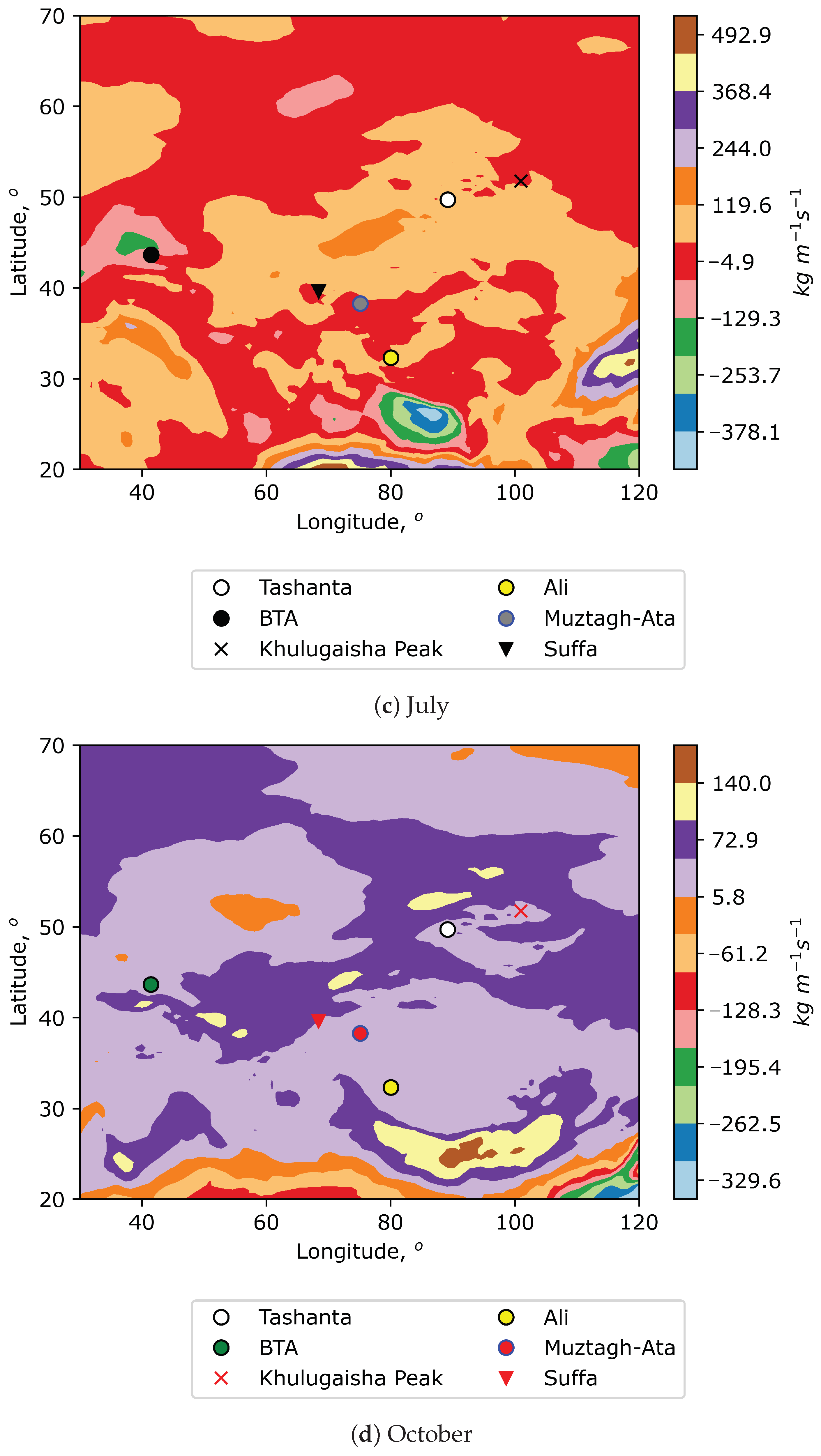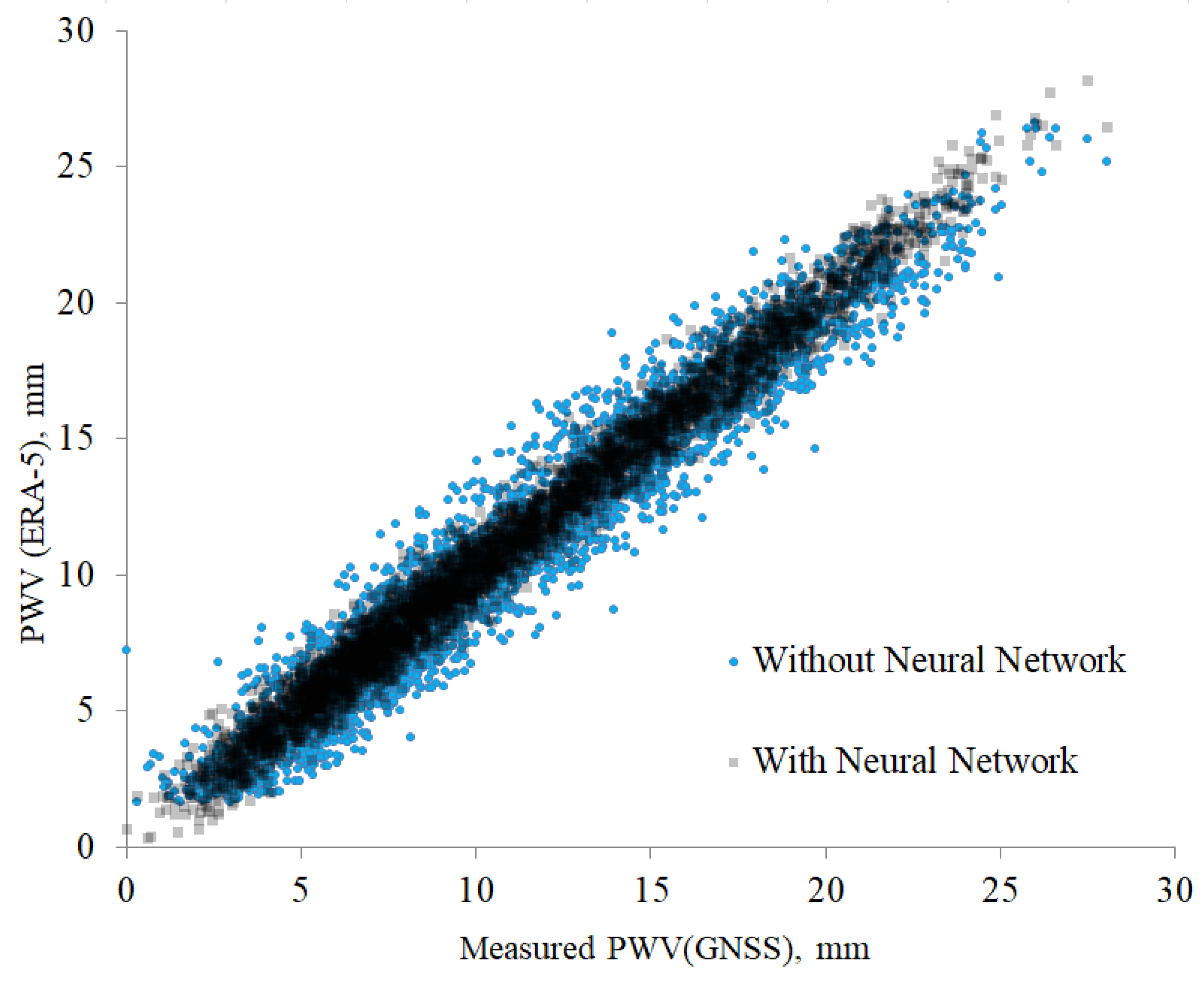Candidate Sites for Millimeter and Submillimeter Ground-Based Telescopes: Atmospheric Rating for the Eurasian Submillimeter Telescopes Project
Abstract
1. Introduction
2. Data Used
3. Atmospheric Characteristics Relevant for Millimeter Telescopes
3.1. Spatial Distributions of PWV Relevant for Placement of Millimeter Telescopes
3.2. Vertical Integrals of Water Vapor Fluxes
4. Machine Learning to Obtain More Accurate Values of PWV for Selected Astronomical Sites
5. Atmospheric Opacities with Millimeter-Wave Propagation Models
6. Conclusions
Author Contributions
Funding
Institutional Review Board Statement
Informed Consent Statement
Data Availability Statement
Acknowledgments
Conflicts of Interest
References
- Antoshkin, L.V.; Botygina, N.N.; Bolbasova, L.A.; Emaleev, O.N.; Konyaev, P.A.; Kopylov, E.A.; Kovadlo, P.G.; Kolobov, D.Y.; Kudryashov, A.V.; Lavrinov, V.V.; et al. Adaptive optics system for solar telescope operating under strong atmospheric turbulence. Atmos. Ocean. Opt. 2017, 30, 291–299. [Google Scholar]
- Wang, L.; Schöck, M.; Chanan, G. Atmospheric turbulence profiling with slodar using multiple adaptive optics wavefront sensors. Appl. Opt. 2008, 47, 1880–1892. [Google Scholar] [PubMed]
- Rochau, B.; Brandner, W.; Stolte, A.; Henning, T.; Da Rio, N.; Gennaro, M.; Hormuth, F.; Marchetti, E.; Amico, P. A benchmark for multiconjugated adaptive optics: VLT–MAD observations of the young massive cluster Trumpler 14. Mon. Not. R. Astron. Soc. 2011, 418, 949–959. [Google Scholar] [CrossRef][Green Version]
- Zhang, L.; Guo, Y.; Rao, C. Solar multi-conjugate adaptive optics based on high order ground layer adaptive optics and low order high altitude correction. Opt. Express 2017, 25, 4356–4367. [Google Scholar] [CrossRef]
- Nosov, V.V.; Lukin, V.P.; Nosov, E.V.; Torgaev, A.V.; Afanas’ev, V.L.; Balega, Y.Y.; Vlasyuk, V.V.; Panchuk, V.E.; Yakopov, G.V. Astroclimate Studies in the Special Astrophysical Observatory of the Russian Academy of Sciences. Atmos. Ocean. Opt. 2019, 32, 8–18. [Google Scholar] [CrossRef]
- Shikhovtsev, A.Y.; Kovadlo, P.G.; Kiselev, A.V. Astroclimatic statistics at the Sayan Solar Observatory. Solar-Terr. Phys. 2020, 6, 102–107. [Google Scholar] [CrossRef]
- Ramasawmy, J.; Klaassen, P.D.; Cicone, C.; Mroczkowski, T.K.; Chen, C.-C.; Cornish, T.; da Cunha, E.; Hatziminaoglou, E.; Johnstone, D.; Liu, D.; et al. The Atacama Large Aperture Submillimetre Telescope: Key science drivers. In Proceedings of the Millimeter, Submillimeter, and Far-Infrared Detectors and Instrumentation for Astronomy XI, Montréal, QC, Canada, 17–22 July 2022; Volume 12190. [Google Scholar] [CrossRef]
- Rudakov, K.I.; Dmitriev, P.N.; Baryshev, A.M.; Khudchenko, A.V.; Hesper, R.; Koshelets, V.P. Low-Noise Sis Receivers for New Radio-Astronomy Projects. Radiophys. Quantum Electron. 2019, 63, 547–555. [Google Scholar] [CrossRef]
- Likhachev, S.F.; Rudnitskiy, A.G.; Andrianov, A.S.; Arkhipov, M.Y.; Baryshev, A.M.; Vdovin, V.F.; Golubev, E.S.; Kostenko, V.I.; Larchenkova, T.I.; Pilipenko, S.V.; et al. Subterahertz Astronomy in the Russian Federation: Prospects and Directions. Cosm. Res. 2024, 62, 117–131. [Google Scholar] [CrossRef]
- Zinchenko, I.I.; Lapinov, A.V.; Vdovin, V.F.; Zemlyanukha, P.M.; Khabarova, T.A. Measurements and Evaluations of the Atmospheric Transparency at Short Millimeter Wavelengths at Candidate Sites for Millimeter- and Sub-Millimeter-Wave Telescopes. Appl. Sci. 2023, 13, 11706. [Google Scholar] [CrossRef]
- Bubnov, G.M.; Abashin, E.B.; Balega, Y.Y.; Bolshakov, O.S.; Dryagin, S.Y.; Dubrovich, V.K.; Marukhno, A.S.; Nosov, V.I.; Vdovin, V.F.; Zinchenko, I.I. Searching for New Sites for THz Observations in Eurasia. IEEE Trans. Terahertz Sci. Technol. 2015, 5, 64–72. [Google Scholar] [CrossRef]
- Bubnov, G.; Vdovin, V.; Khaikin, V.; Tremblin, P.; Baron, P. Analysis of variations in factors of specific absorption of sub-terahertz waves in the Earth’s atmosphere. In Proceedings of the 7th All-Russian Microwave Conference (RMC), Russia, Moscow, 25–27 November 2020; Volume 5, pp. 229–232. [Google Scholar] [CrossRef]
- Balega, Y.; Bataev, D.K.-S.; Bubnov, G.M.; Vdovin, V.F.; Zemlyanukha, P.M.; Lolaev, A.B.; Lesnov, I.V.; Marukhno, A.S.; Marukhno, N.A.; Murtazaev, A.K.; et al. Direct Measurements of Atmospheric Absorption of Subterahertz Waves in the Northern Caucasus. Dokl. Phys. 2022, 61, 1–4. [Google Scholar] [CrossRef]
- Otarola, A.; Breuck, C.D.; Travouillon, T.; Matsushita, S.; Nyman, L.A.; Wootten, A.; Radford, S.J.E.; Sarazin, M.; Kerber, F.; Perez-Beaupuits, J.P. Precipitable Water Vapor, Temperature, and Wind Statistics At Sites Suitable for mm and Submm Wavelength Astronomy in Northern Chile. Publ. Astron. Soc. Pac. 2019, 131, 045001. [Google Scholar] [CrossRef]
- Frans, L.; Backes, M.; Falcke, H. A comparative analysis of GNSS-inferred precipitable water vapour at the potential sites for the Africa Millimetre Telescope. Mon. Not. R. Astron. Soc. 2025, 537, 1357–1368. [Google Scholar] [CrossRef]
- Khaikin, V.; Lebedev, M.; Shmagin, V.; Zinchenko, I.; Vdovin, V.; Bubnov, G.; Edelman, V.; Yakopov, G.; Shikhovtsev, A.; Marchiori, G.; et al. On the Eurasian SubMillimeter Telescopes Project (ESMT). In Proceedings of the 7th All-Russian Microwave Conference (RMC), Moscow, Russia, 25–27 November 2020; pp. 47–51. [Google Scholar] [CrossRef]
- Deng, L.; Yang, F.; Chen, X.; He, F.; Liu, Q.; Zhang, B.; Zhang, C.; Wang, K.; Liu, N.; Ren, A.; et al. Lenghu on the Tibetan Plateau as an astronomical observing site. Nature 2021, 596, 353–356. [Google Scholar] [CrossRef]
- Zhang, J.; Zhao, Y.; Gao, J.; Esamdin, A.; Zhang, W.; Yuan, X.; Feng, G.; Niu, H.; Gu, W.; Zhang, X.; et al. Characterizing long-term astroclimate parameters at the Muztagh-Ata site in the Pamir plateau with ERA5 and MERRA-2 data. Mon. Not. R. Astron. Soc. 2024, 535, 3543–3549. [Google Scholar] [CrossRef]
- Cortés, F.; Cortés, K.; Reeves, R.; Bustos, R.; Radford, S. Twenty years of precipitable water vapor measurements in the Chajnantor area. Astron. Astrophys. 2020, 640, A126. [Google Scholar] [CrossRef]
- Tillayev, Y.; Azimov, A.; Ehgamberdiev, S.; Ilyasov, S. Astronomical Seeing and Meteorological Parameters at Maidanak Observatory. Atmosphere 2023, 14, 199. [Google Scholar] [CrossRef]
- Qian, X.; Yao, Y.; Wang, X.; Zou, L.; Li, Y.; Yin, J. Validation of the WRF Model for Estimating Precipitable Water Vapor at the Ali Observatory on the Tibetan Plateau. Publ. Astron. Soc. Pac. 2020, 132, 125003. [Google Scholar] [CrossRef]
- Khaikin, V.B.; Shikhovtsev, A.Y.; Mironov, A.P.; Qian, X. A Study of the Astroclimate in the Dagestan Mountains Agul Region and at the Ali Observatory in Tibet as Possible Locations for the Eurasian SubMM Telescopes (ESMT). Proc. Sci. 2022, 425, 72. [Google Scholar]
- Bolbasova, L.A.; Kopylov, E.A.; Potanin, S.A. Tashanta as a Promising Astronomical Site in the Altai Mountains Region in Russia: The First Results of the Astroclimate Study. Astron. Rep. 2024, 68, 752–759. [Google Scholar] [CrossRef]
- Shikhovtsev, A.Y.; Kovadlo, P.G.; Khaikin, V.B.; Kiselev, A.V. Precipitable Water Vapor and Fractional Clear Sky Statistics within the Big Telescope Alt-Azimuthal Region. Remote Sens. 2022, 14, 6221. [Google Scholar] [CrossRef]
- Stolyarov, V.A.; Balega, Y.Y.; Mingaliev, M.G.; Sotnikova, Y.V.; Vdovin, V.F.; Gunbina, A.A.; Kukushkin, D.E.; Tarasov, M.A.; Fominsky, M.Y.; Chekushkin, A.M.; et al. Prospects of Millimeter Astronomy Development at the Special Astrophysical Observatory of the Russian Academy of Sciences (SAO RAS). Astrophys. Bull. 2024, 79, 321–339. [Google Scholar] [CrossRef]
- Valeria, L.; Martinez-Ledesma, M.; Reeves, R. Satellite-based atmospheric characterization for sites of interest in millimeter and sub-millimeter astronomy. Astron. Astrophys. 2024, 684, A186. [Google Scholar] [CrossRef]
- Hersbach, H.; Bell, B.; Berrisford, P.; Hirahara, S.; Horányi, A.; Muñoz-Sabater, J.; Nicolas, J.; Peubey, C.; Radu, R.; Schepers, D.; et al. The ERA5 global reanalysis. Q. J. R. Meteorol. Soc. 2020, 146, 1999–2049. [Google Scholar] [CrossRef]
- Shikhovtsev, A.Y.; Kovadlo, P.G.; Lezhenin, A.A.; Gradov, V.S.; Zaiko, P.O.; Khitrykau, M.A.; Kirichenko, K.E.; Driga, M.B.; Kiselev, A.V.; Russkikh, I.V.; et al. Simulating Atmospheric Characteristics and Daytime Astronomical Seeing Using Weather Research and Forecasting Model. Appl. Sci. 2023, 13, 6354. [Google Scholar] [CrossRef]
- Shikhovtsev, M.Y.; Molozhnikova, Y.V. Inter-annual dynamics of regional and transboundary transport of air masses of the Baikal region for 2010–2018. In Proceedings of the 26th International Symposium on Atmospheric and Ocean Optics, Atmospheric Physics, Moscow, Russia, 6–10 July 2020; Volume 11560. [Google Scholar] [CrossRef]
- Molozhnikova, Y.V.; Shikhovtsev, M.Y.; Netsvetaeva, O.G.; Khodzher, T.V. Ecological Zoning of the Baikal Basin Based on the Results of Chemical Analysis of the Composition of Atmospheric Precipitation Accumulated in the Snow Cover. Appl. Sci. 2023, 13, 8171. [Google Scholar] [CrossRef]
- Wang, Z.; Chen, P.; Wang, R. Performance of ERA5 data in retrieving precipitable water vapor over Hong Kong. Adv. Space Res. 2023, 71, 4055–4071. [Google Scholar] [CrossRef]
- Bai, J.; Lou, Y.; Zhang, W.; Zhou, Y.; Zhang, Z.; Shi, C. Assessment and calibration of MODIS precipitable water vapor products based on GPS network over China. Atmos. Res. 2021, 254, 105504. [Google Scholar] [CrossRef]
- Tillayev, Y. Atmospheric parameters affecting astronomical observations at the Maidanak Observatory. In Proceedings of the Observatory Operations: Strategies, Processes, and Systems X, Yokohama, Japan, 17–20 June 2024; Volume 13098. [Google Scholar]
- Lapinov, A.V.; Lapinova, S.A.; Petrov, L.Y.; Ferrusca, D. On the benefits of the Eastern Pamirs for sub-mm astronomy. In Proceedings of the Millimeter, Submillimeter, and Far-Infrared Detectors and Instrumentation for Astronomy X, Online, 2 –14 December 2020; Volume 11453. [Google Scholar] [CrossRef]
- Zhao, Y.; Yang, F.; Chen, X.; Zhang, X.; Ma, J.; Kong, X.; Fu, X.; Li, R.; Wei, Y.; Yao, Z.; et al. Long-term variations in precipitable water vapor and temperature at Lenghu Site. Astron. Astrophys. 2022, 663, A34. [Google Scholar] [CrossRef]
- Qian, X.; Yao, Y.; Wang, X. Research on the forecasting system of atmospheric optical properties at astronomical observatories: A case study of the Ali Observatory above the Tibetan Plateau. In Proceedings of the Adaptive Optics Systems IX, Yokohama, Japan, 16–22 June 2024; Volume 13097. [Google Scholar] [CrossRef]
- Feng, L.; Hao, J.-X.; Cao, Z.-H.; Bai, J.-M.; Yang, J.; Zhou, X.; Yao, Y.-Q.; Hou, J.-L.; Zhao, Y.-H.; Liu, Y. Site testing campaign for the Large Optical/infrared Telescope of China: Overview. Atmos. Res. 2020, 20, 80. [Google Scholar] [CrossRef]
- Xu, J.; Li, M.; Esamdin, A.; Wang, N.; Pu, G.; Wang, L.; Feng, G.; Zhang, X.; Ma, S.; Lv, J.; et al. Site-testing at Muztag-Ata site. IV. Precipitable Water Vapor. Publ. Astron. Soc. Pac. 2022, 134, 015006. [Google Scholar] [CrossRef]
- Kuo, C.-L. Assessments of Ali, Dome A, and Summit Camp for mm-wave Observations Using MERRA-2 Reanalysis. Astrophys. J. 2017, 848, 64. [Google Scholar] [CrossRef]
- Khabarova, T.A.; Zemlyanukha, P.M.; Dombek, E.M.; Marukhno, A.S.; Vdovin, V.F. Analysis of the Results of Astroclimate Measurements in the Millimeter Wavelength Range Using Machine Learning Methods. Astrophys. Bull. 2024, 79, 340–349. [Google Scholar] [CrossRef]
- Adavi, Z.; Ghassemi, B.; Weber, R.; Hanna, N. Machine Learning-Based Estimation of Hourly GNSS Precipitable Water Vapour. Remote Sens. 2023, 15, 4551. [Google Scholar] [CrossRef]
- Pardo, J.R.; Serabyn, E.; Wiedner, M.C.; Cernicharo, J. Measured telluric continuum-like opacity beyond 1 THz. J. Quant. Spectrosc. Radiat. Tranfer 2005, 96, 537–545. [Google Scholar] [CrossRef]
- Liebe, H.J.; Hufford, G.A.; Cotton, M.G. Propagation modeling of moist air and suspended water/ice particles at frequencies below 1000 GHz. In Proceedings of the AGARD 52nd Specialist Meeting of the Electomagnetic Wave Propogation Panel, Palma de Mallorca, Spain, 17–21 May 1993. [Google Scholar]











| Station | Coordinates |
|---|---|
| Arti | N E |
| Aruch-Yerevan | N E |
| Kars | N E |
| Zelenchukskaya | N E |
| Site | PWV, mm (January) | PWV, mm (July) | Data |
|---|---|---|---|
| Ali | 0.8 | 4.8 | ERA-5 |
| Lenghu site | 1.1 | 6.5 | MERRA-2 |
| Lenghu site | 1.2 | 8.6 | ESO website |
| Mauna Kea | 1.9 | 3.9 | ESO website |
| Cerro Paranal | 2.1 | 4.3 | ESO website |
| La Palma | 3.8 | 6.1 | ESO website |
| Tashanta | 1.9 | 12.5 | ERA-5 |
| Khulugaisha Peak | 1.6 | 9.8 | ERA-5 |
| Muztagh-Ata | 1.2 | 6.8 | ECMWF data |
| Muztagh-Ata | 1.2 | 6.8 | ECMWF data |
| Suffa | 2.6 | 9.5 | ERA-5 |
| Maidanak | 3.2 | 9.1 | GPS |
| Sanglokh | 3.0 | 9.8 | ERA-5 |
| Koluch-Kul | 1.4 | 7.8 | ERA-5 |
| Khulugaisha Peak | Tashanta | |||||
|---|---|---|---|---|---|---|
| 100 GHz | 150 GHz | 225 GHz | 100 GHz | 150 GHz | 225 GHz | |
| Month | Opacity | Opacity | Opacity | Opacity | Opacity | Opacity |
| LIEBE | ||||||
| 1 | 0.06 | 0.07 | 0.12 | 0.07 | 0.08 | 0.14 |
| 2 | 0.06 | 0.06 | 0.11 | 0.06 | 0.06 | 0.10 |
| 3 | 0.07 | 0.09 | 0.17 | 0.08 | 0.10 | 0.18 |
| 4 | 0.09 | 0.14 | 0.28 | 0.09 | 0.12 | 0.25 |
| 5 | 0.10 | 0.16 | 0.34 | 0.12 | 0.21 | 0.46 |
| 6 | 0.13 | 0.24 | 0.52 | 0.12 | 0.22 | 0.48 |
| 7 | 0.12 | 0.24 | 0.51 | 0.12 | 0.22 | 0.48 |
| 8 | 0.10 | 0.19 | 0.40 | 0.11 | 0.20 | 0.42 |
| 9 | 0.10 | 0.17 | 0.35 | 0.10 | 0.16 | 0.33 |
| 10 | 0.07 | 0.10 | 0.19 | 0.08 | 0.11 | 0.23 |
| 11 | 0.07 | 0.08 | 0.15 | 0.07 | 0.09 | 0.18 |
| 12 | 0.05 | 0.05 | 0.09 | 0.06 | 0.06 | 0.11 |
| HITRAN | ||||||
| 1 | 0.10 | 0.10 | 0.17 | 0.13 | 0.14 | 0.23 |
| 2 | 0.11 | 0.10 | 0.17 | 0.13 | 0.13 | 0.20 |
| 3 | 0.12 | 0.13 | 0.22 | 0.15 | 0.17 | 0.30 |
| 4 | 0.13 | 0.17 | 0.30 | 0.16 | 0.21 | 0.38 |
| 5 | 0.13 | 0.18 | 0.35 | 0.19 | 0.32 | 0.64 |
| 6 | 0.14 | 0.23 | 0.47 | 0.20 | 0.34 | 0.69 |
| 7 | 0.14 | 0.23 | 0.45 | 0.19 | 0.34 | 0.70 |
| 8 | 0.13 | 0.19 | 0.37 | 0.18 | 0.31 | 0.63 |
| 9 | 0.12 | 0.18 | 0.35 | 0.17 | 0.26 | 0.51 |
| 10 | 0.11 | 0.13 | 0.23 | 0.15 | 0.19 | 0.36 |
| 11 | 0.11 | 0.11 | 0.19 | 0.14 | 0.17 | 0.29 |
| 12 | 0.09 | 0.09 | 0.14 | 0.12 | 0.12 | 0.20 |
| JPL | ||||||
| 1 | 0.10 | 0.10 | 0.17 | 0.12 | 0.14 | 0.23 |
| 2 | 0.10 | 0.10 | 0.16 | 0.12 | 0.12 | 0.20 |
| 3 | 0.12 | 0.13 | 0.21 | 0.15 | 0.17 | 0.29 |
| 4 | 0.13 | 0.16 | 0.29 | 0.16 | 0.20 | 0.37 |
| 5 | 0.13 | 0.18 | 0.34 | 0.20 | 0.32 | 0.63 |
| 6 | 0.14 | 0.23 | 0.46 | 0.20 | 0.34 | 0.68 |
| 7 | 0.14 | 0.22 | 0.44 | 0.20 | 0.34 | 0.69 |
| 8 | 0.12 | 0.19 | 0.36 | 0.18 | 0.31 | 0.62 |
| 9 | 0.12 | 0.18 | 0.34 | 0.17 | 0.26 | 0.50 |
| 10 | 0.11 | 0.13 | 0.22 | 0.15 | 0.19 | 0.35 |
| 11 | 0.10 | 0.11 | 0.19 | 0.14 | 0.16 | 0.29 |
| 12 | 0.09 | 0.09 | 0.14 | 0.11 | 0.12 | 0.19 |
Disclaimer/Publisher’s Note: The statements, opinions and data contained in all publications are solely those of the individual author(s) and contributor(s) and not of MDPI and/or the editor(s). MDPI and/or the editor(s) disclaim responsibility for any injury to people or property resulting from any ideas, methods, instructions or products referred to in the content. |
© 2025 by the authors. Licensee MDPI, Basel, Switzerland. This article is an open access article distributed under the terms and conditions of the Creative Commons Attribution (CC BY) license (https://creativecommons.org/licenses/by/4.0/).
Share and Cite
Shikhovtsev, A.Y.; Kovadlo, P.G.; Baron, P. Candidate Sites for Millimeter and Submillimeter Ground-Based Telescopes: Atmospheric Rating for the Eurasian Submillimeter Telescopes Project. Sensors 2025, 25, 2144. https://doi.org/10.3390/s25072144
Shikhovtsev AY, Kovadlo PG, Baron P. Candidate Sites for Millimeter and Submillimeter Ground-Based Telescopes: Atmospheric Rating for the Eurasian Submillimeter Telescopes Project. Sensors. 2025; 25(7):2144. https://doi.org/10.3390/s25072144
Chicago/Turabian StyleShikhovtsev, Artem Y., Pavel G. Kovadlo, and Philippe Baron. 2025. "Candidate Sites for Millimeter and Submillimeter Ground-Based Telescopes: Atmospheric Rating for the Eurasian Submillimeter Telescopes Project" Sensors 25, no. 7: 2144. https://doi.org/10.3390/s25072144
APA StyleShikhovtsev, A. Y., Kovadlo, P. G., & Baron, P. (2025). Candidate Sites for Millimeter and Submillimeter Ground-Based Telescopes: Atmospheric Rating for the Eurasian Submillimeter Telescopes Project. Sensors, 25(7), 2144. https://doi.org/10.3390/s25072144








